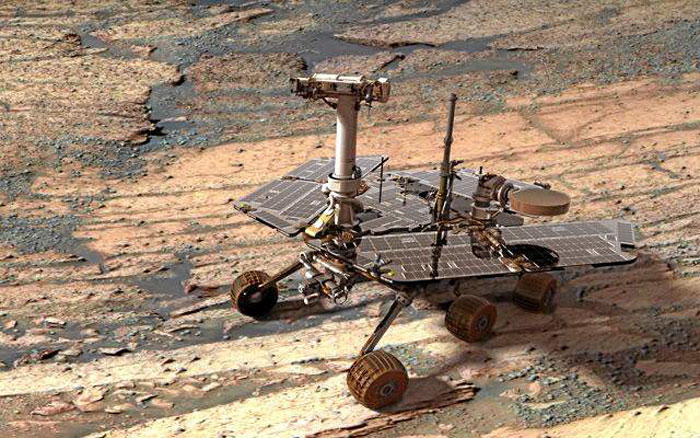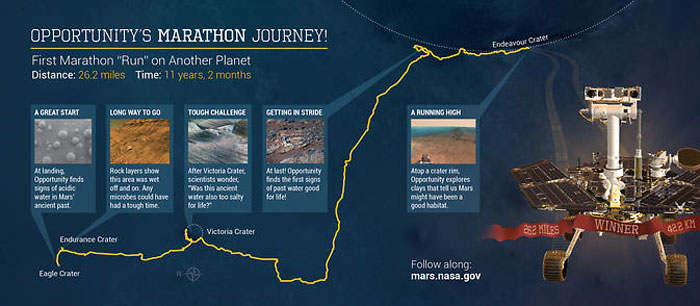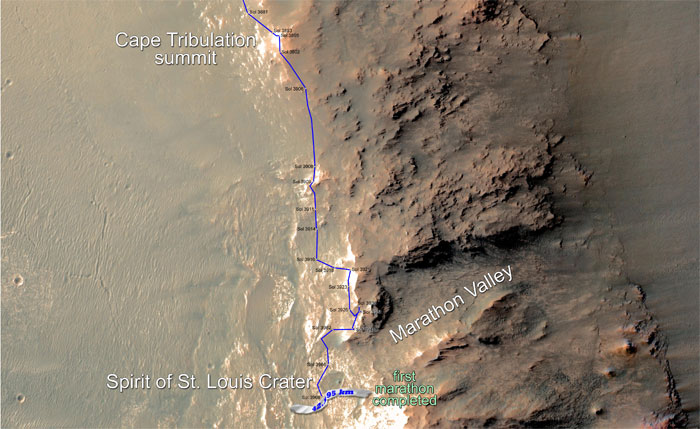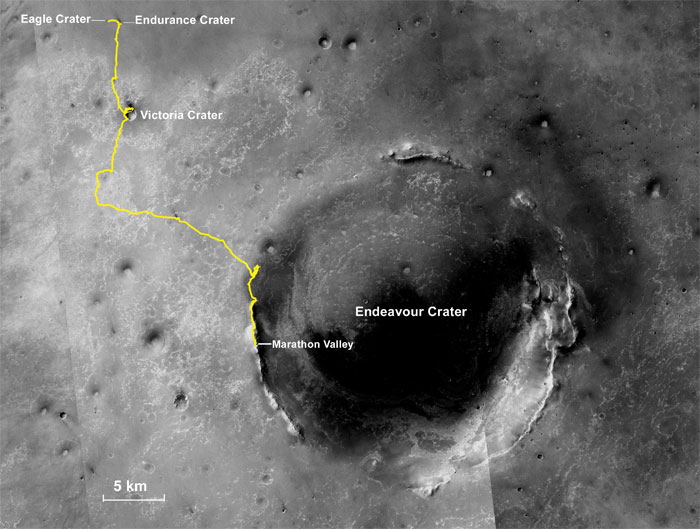.

A digital model of the Opportunity rover was added to a real image of the inside of Endurance Crater on Mars taken earlier by Opportunity itself. The size of the six-wheeled robot was scaled to the size of the tracks that the Opportunity rover actually created. Credit: Mars Exploration Rover Mission, Cornell, JPL, NASA
.
LA CAÑADA FLINTRIDGE >> Eleven years and two months after a hypothetical race began, NASA’s Opportunity rover glided to the finish line of the first off-Earth marathon, the agency announced Tuesday.
“This is the first time any human enterprise has exceeded the distance of a marathon on the surface of another world,” John Callas, Opportunity project manager at NASA’s Jet Propulsion Laboratory, said in a statement.
Launched on July 7, 2003, Opportunity landed on Mars on Jan. 25, 2004. As a single-string rover, it doesn’t have any electronic redundancies. So if something goes haywire, that’s the end of that function.
The rover originally had a three-month prime mission but has continued to operate way beyond its expected lifespan.
Its twin rover, Spirit, went out of commission in March 2010 after six years, 4.8 miles and about 128,000 raw images, according to the Mars Exploration website.
“This mission isn’t about setting distance records, of course; it’s about making scientific discoveries on Mars and inspiring future explorers to achieve even more,” Steve Squyres, Opportunity principal investigator at Cornell University, said in a statement. “Still, running a marathon on Mars feels pretty cool.”
In June, Opportunity became the world’s long-distance champion when it beat a previous record set by the former Soviet Union’s Lunokhod 2 moon rover. At the time, Opportunity’s odometer read 25 miles.
The rover’s final “sprint” to the finish line was a 153-feet drive.
NASA’s Opportunity team at JPL plans to run a 26.2-mile relay at the laboratory next week to celebrate the rover’s accomplishment.
In its scientific capacity -- not as an endurance athlete -- Opportunity provided evidence of ancient Martian environments where liquid water soaked the ground and flowed on the Red Planet’s surface. In Endeavour Crater, it also discovered ancient wet conditions less acidic and more favorable for microbial life.
Quelle: Pasadena Star News
-
NASA's Opportunity Mars Rover Finishes Marathon, Clocks in at Just Over 11 Years
.

This illustration depicts some highlights along the route as NASA's Mars Exploration Rover Opportunity drove as far as a marathon race during the first 11 years and two months after its January 2004 landing in Eagle Crater. The vehicle surpassed marathon distance of 26.219 miles (42.195 kilometers) with a drive completed on March 24, 2015, during the 3,968th Martian day, or sol, of Opportunity's work on Mars. For this map, north is on the left.
Image Credit: NASA/JPL-Caltech/Cornell Univ./USGS/Arizona State Univ.
.
There was no tape draped across a finish line, but NASA is celebrating a win. The agency’s Mars Exploration Rover Opportunity completed its first Red Planet marathon Tuesday -- 26.219 miles (42.195 kilometers) – with a finish time of roughly 11 years and two months.


"This is the first time any human enterprise has exceeded the distance of a marathon on the surface of another world," said John Callas, Opportunity project manager at NASA's Jet Propulsion Laboratory (JPL) in Pasadena, California. "A first time happens only once."
The rover team at JPL plans a marathon-length relay run at the laboratory next week to celebrate.
The long-lived rover surpassed the marathon mark during a drive of 153 feet (46.5 meters). Last year, Opportunity became the long-distance champion of all off-Earth vehicles when it topped the previous record set by the former Soviet Union's Lunokhod 2 moon rover.
"This mission isn't about setting distance records, of course; it's about making scientific discoveries on Mars and inspiring future explorers to achieve even more," said Steve Squyres, Opportunity principal investigator at Cornell University in Ithaca, New York. "Still, running a marathon on Mars feels pretty cool."
Opportunity's original three-month prime mission in 2004 yielded evidence of environments with liquid water soaking the ground and flowing on planet’s surface. As the rover continued to operate far beyond expectations for its lifespan, scientists chose the rim of Endeavour Crater as a long-term destination. Since 2011, examinations of Endeavour's rim have provided information about ancient wet conditions less acidic, and more favorable for microbial life, than the environment that left clues found earlier in the mission.
JPL manages the Mars rover projects for NASA's Science Mission Directorate in Washington. The Mars Exploration Rover Project, NASA's newer Curiosity Mars rover, and three active NASA Mars orbiters are part of NASA's Mars Exploration Program, which seeks to characterize and understand Mars as a dynamic system, including its present and past environment, climate cycles, geology and biological potential. In parallel, NASA is developing the human spaceflight capabilities needed for its journey to Mars.
.

This map shows the southward path driven by Opportunity from late December 2014 until it passed marathon distance on March 24, 2015, during the 3,968th Martian day, or sol, of the rover's work on Mars.
Image Credit: NASA/JPL-Caltech/Univ. of Arizona
.

This map shows the rover's entire traverse from landing to that point.
Image Credit: NASA/JPL-Caltech/MSSS/NMMNHS
Quelle: NASA
4821 Views
